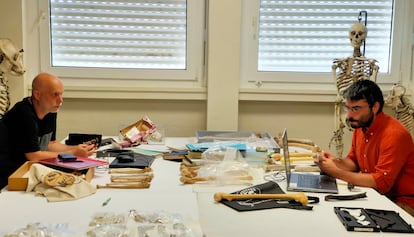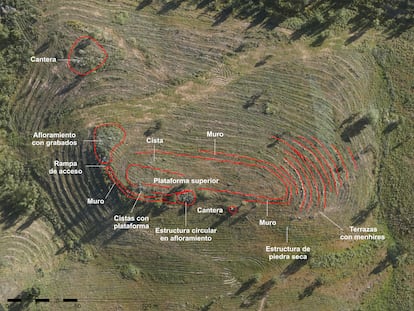The femur shaking up the history of human evolution: Were our ancestors bipedal as far back as seven million years ago?
The bone was discovered in 2001 in Chad. Since then, it has been the subject of a fierce war between scientist colleagues

Humanity still does not know what creatures it came from. The human family split from the chimpanzee family between six and 10 million years ago. That last common ancestor is an enigma, but a seven-million-year-old femur now illuminates that dark period of evolution. The bone, found in Central Africa in 2001, points to the fact that the oldest members of the human family – beings weighing 50 kilos and just over a meter tall, belonging to the species Sahelanthropus tchadensis – already possessed one of the most characteristic behaviors of people: they walked on two legs.
The femur has been involved in one of the fiercest wars in the history of paleoanthropology. The bone turned up alongside numerous animal fossils on July 19, 2001, at the Toros-Menalla site in Chad, but was overshadowed by the discovery of a majestic seven-million-year-old skull. The director of the excavations, French paleontologist Michel Brunet, from the University of Poitiers, proclaimed that they had found “the beginning of the lineage of the human being.”
The skull, as its discoverers then explained, belonged to a hominid with a brain similar in size to that of a chimpanzee, but which was already possibly bipedal, judging by the place of insertion of the vertebral column in its head. The individual was baptized Toumaï, as babies born just before the dry season are called in the desert of Chad. It means “hope to live” in the local language. The new species was recorded as Sahelanthropus tchadensis.
The real soap opera began in 2004, when a young student, Aude Bergeret, came across the femur in a collection of indeterminate animal bones at the University of Poitiers. Suspecting that it could be from the left leg of Toumaï or from another specimen of the same species, and given that Michel Brunet was excavating in Chad, the student showed the femur to another professor from the same institution, Roberto Macchiarelli. After a preliminary analysis, both concluded that the Sahelanthropus tchadensis moved on all fours and was not closely related to the human family. They did not publish their results until 2020.
A new, more exhaustive study of the same femur argues the opposite: the Sahelanthropus tchadensis “usually” walked on two legs. The work was published Wednesday in Nature. The species thus joins other later ones that also moved on two legs at the beginning of the human family, such as Orrorin tugenensis, which lived in what is now Kenya about six million years ago, and Ardipithecus ramidus, who walked about 4.4 million years ago through present-day Ethiopia.
Paleontologist Guillaume Daver is one of the co-directors of the new study at the University of Poitiers. His team does not believe that the ability to walk on two legs arose independently in different species. Daver argues that the most logical thing is that “this behavior appeared only once throughout human evolution: either it was inherited from the last common ancestor or it arose soon after the divergence between chimpanzees and humans.” The collective imagination, influenced by religious stories, perceives evolution as a straight path from the primitive quadrupeds to the perfection of the human being, but reality is more like a leafy tree with intersecting branches. Chimpanzees, which are quadrupedal, may or may not be descended from a bipedal ancestor.
One of the living legends of paleoanthropology, Tim White, moved to Spain this year to become a scientist with the National Center for Research on Human Evolution in Burgos. In 1979, he was one of the researchers who presented the world with the remains of Lucy, a one-meter-tall Australopithecus that showed that human ancestors walked on two legs more than three million years ago in what is now Ethiopia. In 2009, White announced another landmark discovery: the skeleton of Ardi, a female of a new extinct species, Ardipithecus ramidus, who 4.4 million years ago could walk upright on the ground and move nimbly through tree branches using of a huge opposable thumb on her foot.
Tim White agrees with the new study, in which he has not participated. The Sahelanthropus tchadensis did walk on two legs. “Their conclusion is fully consistent with everything we know about early hominins: they were definitely neither like modern chimpanzees nor modern humans, but had already evolved in the direction of later hominins from the last common ancestor we shared with chimpanzees today,” says White, who uses the word hominids to refer exclusively to bipedal primates.
Macchiarelli, however, contradicts his colleagues at the University of Poitiers. In his opinion, the new study “omits indications” that the Sahelanthropus tchadensis were quadrupedal, and its authors “lie” about the origin of the femur. “[The student] Aude Bergeret saved the bone from destruction in 2004 and they don’t even mention her. They fired her and seized the material. Taking more than 20 years to carry out an analysis is a new world record,” criticizes Macchiarelli.
The atmosphere inside the University of Poitiers is explosive. The co-directors of the new work, Guillaume Daver and Franck Guy, defend themselves against the accusations. They claim that Macchiarelli and Bergeret concluded that Sahelanthropus tchadensis were quadrupedal from a preliminary analysis of the femur, based primarily on photographs taken before the adhering sediments were cleaned from the bone. Macchiarelli himself admits over the phone that he has never held the femur in his hand.
Michel Brunet, head of the team that discovered the remains in 2001, began digging in the inhospitable desert of Chad in 1994. Today he is 82 years old and says he did not want to participate in the new analysis. “There has been too much strange behavior around these fossils since their discovery. As I am a young paleontologist, I value and need more tranquility and greater intelligence to enjoy science,” he jokes.
Brunet justifies the delay of more than two decades. “My team was just digging more in Chad and waiting for more fossils to turn up,” he says. The rest, he says, is “a sad story written by paleoanthropologists on the couch, with a lot of unacceptable behavior,” a clear allusion to Roberto Macchiarelli and Aude Bergeret. The former student, today director of the Jacques de La Comble Natural History Museum in Autun (France), declines to comment on the new study. “For my part, I am glad that, after all this time, there can finally be a scientific debate about the femur,” replies Bergeret.
In addition to the controversial femur, the new work analyzes two ulnae – forearm bones – also found at the same site in Chad in 2001. While the characteristics of the femur suggest that the Sahelanthropus tchadensis walked on the ground on two legs, the two ulnae suggest that they could also climb trees with agility According to evolutionary biologist Daniel Lieberman, of Harvard University, the verdict is not definitive. “The femur of Sahelanthropus does not present irrefutable evidence of bipedalism, but it is more similar to that of a bipedal hominin than that of a quadrupedal ape,” he says in an independent commentary published in Nature.
The scenario of human evolution is now left with Sahelanthropus walking on two legs and climbing trees seven million years ago, perhaps similar to how Ardipithecus ramidus did 4.4 million years ago. The rest of the story is better known. Australopithecines, other members of the human family, evolved about three million years ago and perfected their two-legged walk, until members of the genus Homo emerged.
After decades of controversy and risky excavations in the Chad desert, veteran Michel Brunet believes that this may be the end point of the debate about whether Sahelanthropus tchadensis walked on two legs: “In scientific terms, this is definitely the end of the debate, but we’ll see, because all this is also a human story.”
Tu suscripción se está usando en otro dispositivo
¿Quieres añadir otro usuario a tu suscripción?
Si continúas leyendo en este dispositivo, no se podrá leer en el otro.
FlechaTu suscripción se está usando en otro dispositivo y solo puedes acceder a EL PAÍS desde un dispositivo a la vez.
Si quieres compartir tu cuenta, cambia tu suscripción a la modalidad Premium, así podrás añadir otro usuario. Cada uno accederá con su propia cuenta de email, lo que os permitirá personalizar vuestra experiencia en EL PAÍS.
¿Tienes una suscripción de empresa? Accede aquí para contratar más cuentas.
En el caso de no saber quién está usando tu cuenta, te recomendamos cambiar tu contraseña aquí.
Si decides continuar compartiendo tu cuenta, este mensaje se mostrará en tu dispositivo y en el de la otra persona que está usando tu cuenta de forma indefinida, afectando a tu experiencia de lectura. Puedes consultar aquí los términos y condiciones de la suscripción digital.
More information
Últimas noticias
Trump claims peace in Ukraine is near, but Moscow suggests otherwise
A survivor’s account of the Interoceanic Train accident: ‘We were scared because of the speed on the curve’
The Interoceanic Train, the Mexican alternative to the Panama Canal
What is known about the Interoceanic Train derailment in Oaxaca
Most viewed
- Oona Chaplin: ‘I told James Cameron that I was living in a treehouse and starting a permaculture project with a friend’
- Reinhard Genzel, Nobel laureate in physics: ‘One-minute videos will never give you the truth’
- Why the price of coffee has skyrocketed: from Brazilian plantations to specialty coffee houses
- Pablo Escobar’s hippos: A serious environmental problem, 40 years on
- Chevy Chase, the beloved comedian who was a monster off camera: ‘Not everyone hated him, just the people who’ve worked with him’











































